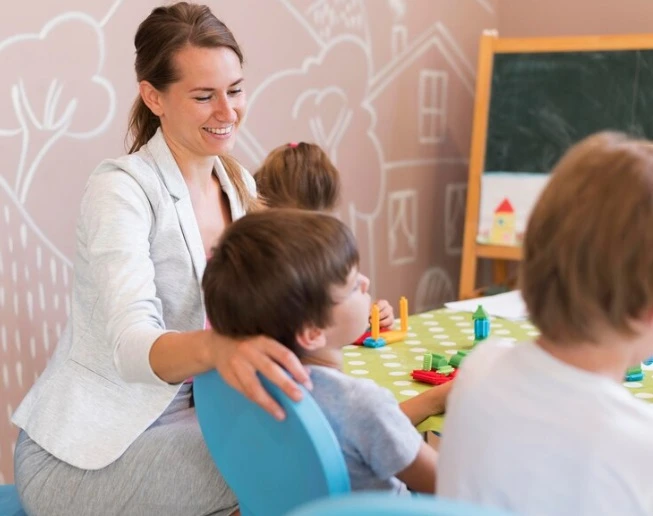Baby monitor cameras offer parents peace of mind by providing real-time audio and video surveillance of their baby’s sleeping area. It allows them to check on their child without physically entering the room, which can be especially useful during naptime or nighttime. When choosing a baby monitor camera, it’s essential to consider features that align with your specific needs and preferences.
You can purchase the great Baby monitor BM07 online now!
Where to put baby monitor
Placing a baby monitor strategically is important for ensuring the safety and well-being of your child. Here are some tips on where to put a baby monitor:
Near the Crib or Bassinet: The most critical location is near your baby’s crib or bassinet to capture clear audio and video of your baby.
Ensure that the camera provides a good view of the entire sleeping area.
Away from the Baby’s Reach: Place the monitor out of your baby’s reach to prevent them from accidentally knocking it over or playing with it.
Avoid Direct Contact: Avoid placing the baby monitor directly inside the crib or bassinet to minimize any potential safety hazards.
Optimal Viewing Angle: Position the camera at an angle that provides a clear view of your baby, including their face and any potential trouble spots.
Consider Mounting Options: If possible, use wall mounts or other secure fixtures to position the camera at the desired angle.
Check Wireless Signal Strength: Ensure that the baby monitor has a strong and reliable wireless signal. Avoid interference from other devices that may disrupt the signal.
Temperature and Humidity Monitoring: If your baby monitor includes sensors for temperature and humidity, place it in a location where it can accurately measure these factors in the baby’s room.
Night Vision Considerations: If the monitor has night vision capabilities, position it so that it provides a clear view even in low-light conditions.
Away from Electronic Interference: Keep the baby monitor away from other electronic devices that may cause interference, such as cordless phones or Wi-Fi routers.
Accessibility: Ensure that the monitor is easily accessible for adjusting settings, checking the video feed, and listening to audio.
Power Outlet Access: Place the baby monitor close to a power outlet if it requires constant power. If using a battery-powered monitor, ensure it’s charged regularly.
Consider Additional Features: Some baby monitors come with features like lullabies, two-way communication, or motion sensors. Place the monitor where these features can be utilized effectively.
Remember to follow the manufacturer’s guidelines and instructions for installing and using the baby monitor. Additionally, periodically check the monitor’s functionality to ensure it is working properly and providing a reliable view of your baby.
What is baby monitor camera
A baby monitor camera, also known as a baby camera or baby monitor with a camera, is a device designed to allow parents or caregivers to remotely monitor their infants or young children. It typically consists of two main components: a camera unit and a parent unit (receiver or monitor).
Key features of a baby monitor camera:
Camera Unit:
Video Camera: The camera captures live video footage of the baby’s room, allowing parents to visually monitor their child.
Night Vision: Many baby monitors come with infrared or night vision capabilities, enabling clear video monitoring in low-light or dark conditions.
Pan-and-Tilt Functionality: Some cameras can be remotely controlled to pan, tilt, and zoom, providing a broader view of the room.
Two-Way Communication: This feature allows parents to talk to their baby through a built-in speaker and microphone on the camera unit.
Parent Unit:
Display Screen: The parent unit typically has a display screen to show the live video feed from the camera.
Audio Monitoring: In addition to video, baby monitors often have audio capabilities, allowing parents to hear sounds from the baby’s room.
Alerts and Notifications: Monitors may include features like temperature sensors, motion detectors, or sound-activated alerts to notify parents of changes or potential issues.
Portability: Many baby monitor parent units are portable, allowing parents to carry them around the house or even outside within a specified range.
Additional Features:
Lullabies and Soothing Sounds: Some baby monitors have built-in lullabies or soothing sounds that can be remotely activated to help comfort the baby.
Temperature and Humidity Sensors: Some models include sensors to monitor the temperature and humidity levels in the baby’s room.
Wi-Fi Connectivity: Modern baby monitors may connect to Wi-Fi, enabling parents to view the video feed on their smartphones or other devices.

How to choose a baby monitor ?
Choosing the right baby monitor involves considering your specific needs, preferences, and the features that will best suit your lifestyle. Here are some factors to consider when selecting a baby monitor:
Type of Monitor:
Audio-only or Video: Decide whether you want an audio-only monitor or one with video capabilities. Video monitors allow you to see your baby, providing an additional layer of reassurance.
Range and Signal Quality:
Range: Consider the size of your home and choose a monitor with a range that covers the necessary distance. This is crucial to maintain a reliable connection between the camera and the parent unit.
Portability:
Handheld or Smartphone App: Some monitors come with handheld parent units, while others connect to smartphones or tablets via apps. Choose a format that aligns with your preferences for portability and convenience.
Camera Features:
Night Vision: Ensure the camera has night vision capabilities for clear monitoring in low-light conditions.
Pan-and-Tilt: If you want to be able to adjust the camera angle remotely, choose a monitor with pan-and-tilt functionality.
Zoom: Some monitors offer zoom capabilities, allowing you to get a closer look at your baby.
Two-Way Communication:
A monitor with two-way communication allows you to talk to your baby through the monitor. This feature can be comforting for both parents and infants.
Additional Sensors:
Temperature and Humidity Sensors: Monitors with these sensors can provide information about the conditions in your baby’s room.
Motion Detection: Some monitors have motion sensors that can alert you if there is movement in the baby’s room.
Alerts and Notifications:
Choose a monitor with customizable alerts, such as temperature warnings or sound-activated alerts, to notify you of changes in the baby’s environment.
Ease of Use:
Consider the user interface and ease of setup. Look for a monitor that is user-friendly and doesn’t require a steep learning curve.
If opting for a handheld parent unit, check the battery life to ensure it meets your needs, especially if you plan to carry it around the house.
Interference and Security:
Look for monitors with secure connections to prevent interference from other devices. Models with encrypted signals can enhance the security of your baby’s monitor.
Budget:
Set a budget for your baby monitor and explore options within that range. While more features can be beneficial, prioritize the ones that are most important to you.
Brand Reputation and Reviews:
Research and read reviews about different baby monitor brands and models. Consider the reputation of the manufacturer and the experiences of other parents.
By carefully considering these factors, you can choose a baby monitor that meets your specific needs and provides you with peace of mind while your baby sleeps or plays in another room.
Why do you need a baby monitor camera
A baby monitor camera serves several purposes, providing parents with added convenience and peace of mind as they care for their infants and young children. Here are some reasons why you might consider using a baby monitor camera:
Remote Monitoring:
Visibility: A video monitor allows parents to see their baby without physically entering the room. This can be particularly helpful during naptime or bedtime.
Safety and Security:
Immediate Alerts: Monitors equipped with motion sensors or sound-activated alerts can notify parents of any changes or potential issues in the baby’s room, enhancing safety.
Sleep Monitoring:
Observation of Sleep Patterns: Video monitors enable parents to observe their baby’s sleep patterns and behaviors, helping them understand their child’s sleep habits and needs.
Comfort and Reassurance:
Two-Way Communication: The ability to talk to your baby through the monitor can provide comfort and reassurance, helping to soothe them back to sleep without entering the room.
Nighttime Monitoring:
Night Vision: Many baby monitor cameras come with night vision capabilities, allowing parents to monitor their baby even in low-light or dark conditions.
Parental Convenience:
Portability: With handheld parent units or smartphone apps, parents can carry the monitor with them around the house, providing flexibility and convenience.
Temperature and Humidity Monitoring:
Environmental Conditions: Monitors equipped with sensors can provide information about the temperature and humidity levels in the baby’s room, ensuring a comfortable sleeping environment.
Sibling Monitoring:
Monitoring Multiple Children: If you have more than one child, a baby monitor camera can help you keep an eye on multiple children simultaneously.
Peace of Mind:
Visual Confirmation: Being able to visually confirm that your baby is safe and comfortable can offer peace of mind to parents, especially during the night or when they are in a different part of the house.
Early Intervention:
Prompt Response: Video monitors allow parents to respond promptly to their baby’s needs, such as hunger or discomfort, reducing the time it takes to attend to the child.
Connection for Working Parents:
Working from Home: For parents working from home, a baby monitor camera can provide a connection to their child while they focus on work tasks.
While not every parent may feel the need for a baby monitor camera, many find them to be valuable tools that contribute to the overall safety, well-being, and peace of mind for both parents and their babies. The choice to use a baby monitor camera ultimately depends on individual preferences, parenting styles, and specific needs.
When to stop using baby monitor ?
The decision to stop using a baby monitor depends on various factors, including the child’s age, developmental milestones, the layout of your home, and your personal comfort level as a parent.
Here are some considerations to help you determine when to stop using a baby monitor:
Age and Development: As children grow and become more independent, they may not require the same level of monitoring. Once your child is old enough to sleep through the night consistently and can communicate their needs, the need for constant monitoring may decrease.
Sleeping Patterns:
If your child has established healthy sleep patterns and consistently sleeps through the night without interruptions, you may feel more confident in reducing or eliminating the use of a baby monitor.
Safety Measures in Place:
If your home is childproofed, and you have taken necessary safety measures, you may be more comfortable with reducing monitoring. This is especially true if your child has moved from a crib to a bed.
Communication Skills:
When your child is old enough to communicate effectively and express their needs, you may find that the constant monitoring provided by a baby monitor is less essential.
Parental Comfort Level:
Ultimately, the decision to stop using a baby monitor is a personal one. Some parents continue using monitors for an extended period for peace of mind, while others may feel confident in discontinuing use earlier.
Transition to a Toddler Bed:
If your child transitions from a crib to a toddler bed, you may choose to continue using a monitor during this adjustment period. Once your child becomes accustomed to the new sleeping arrangement, you may reconsider the need for monitoring.
Home Layout:
If you live in a smaller home or an apartment where you can quickly hear your child without a monitor, you might feel comfortable discontinuing its use earlier.
Sibling Dynamics:
If you have multiple children sharing a room, you may choose to keep a monitor in place for longer to monitor interactions between siblings.
Personal Preference:
Some parents continue using baby monitors well into the toddler years for peace of mind, while others find that they are comfortable discontinuing use earlier.
It’s important to note that there is no strict rule for when to stop using a baby monitor. It’s a decision that varies from family to family. As your child grows and their sleep patterns and communication skills develop, you can reassess the need for ongoing monitoring and make a decision based on your specific circumstances.








